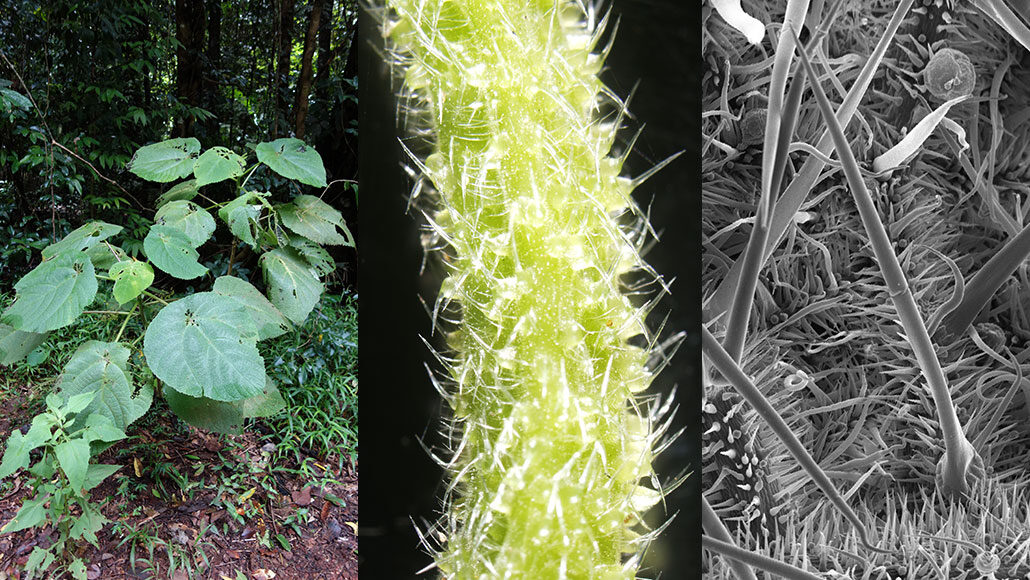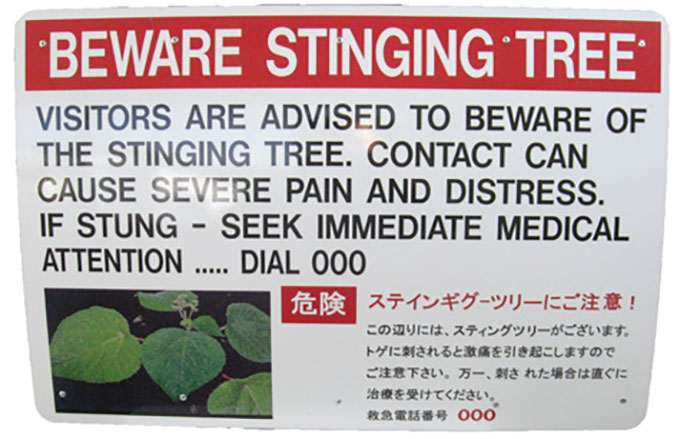Please do not touch the Australian stinging tree
Its leaves are covered with sharp needles that inject a spider-like venom

Stinging trees (left) look harmless. But their stems and petioles (middle) are covered with tiny, needle-like hairs (right) that inject venom under the skin.
(from left) T. Durek; T. Durek; Darren Brown/ Univ. of Queensland
Australia is famous for its dangerous wildlife. The continent is crawling with crocodiles, spiders, snakes and deadly cone snails. Its plants can pack a punch too. The stinging tree, for instance, delivers severe pain to anyone who touches it. Now scientists have identified its secret weapon. And the structure of this pain-producing chemical looks a lot like spider venom.
Stinging trees grow in the rainforest of eastern Australia. They are called gympie-gympies by the Indigenous Gubbi Gubbi people. The trees’ leaves look velvety-soft. But experienced visitors know not to touch. There are even signs that warn, “Beware stinging tree.”

A brush with the tree is as “surprising as an electric shock,” says Thomas Durek. He is a biochemist at the University of Queensland in Brisbane, Australia. He took part in the new study.
“You get some very bizarre sensations: crawling, shooting and tingling pains, and a deep aching that feels like you are being slammed between two bricks,” says neuroscientist Irina Vetter. She also works at the University of Queensland and took part in the study. Vetter notes that the pain has staying power. It can be triggered days or even weeks after an encounter while taking a shower or scratching the area that came in contact with the tree.
The sting is delivered by tiny hairs that cover the leaves, stems and fruits. The hollow hairs are made of silica, the same substance in glass. The hairs act like tiny hypodermic needles. With the slightest touch, they inject venom into the skin. This is probably a defense against hungry herbivores. But some animals can munch the leaves without any ill effects. Examples include some beetles and rainforest kangaroos called pademelons.
The research team set out to identify what chemicals caused all the pain. First they removed the venomous mix from the hairs. Then they separated the mix into individual ingredients. To test whether any of the chemicals caused pain, they injected a low dose of each into the back paw of a mouse. One of the chemicals caused mice to shake and lick their paw for about an hour.
The team analyzed this chemical. They discovered it represented a new family of proteins. These pain-producing substances resemble toxins from venomous animals. The researchers reported their findings September 16 in Science Advances.
Pain-causing proteins
The research team discovered that stinging tree toxins are made of 36 amino acids. Amino acids are the building blocks of proteins. The stinging tree toxins are small proteins called peptides. The particular order of amino acids in these peptides had never before been seen. But their folded shape looked familiar to the researchers. They had the same shape as venom proteins from spiders and cone snails, Vetter says.
The peptides target tiny pores called sodium channels. These pores sit in the membrane of nerve cells. They carry pain signals in the body. When triggered, the pores open. Sodium now flows into the nerve cell. This sends a pain signal that travels from nerve endings in the skin all the way to the brain.
The stinging tree toxin works by locking the channel into its open state. “So, this signal is constantly being sent to the brain: pain, pain, pain,” explains Shab Mohammadi. She’s an evolutionary biologist at the University of Nebraska in Lincoln. She wasn’t involved in the study but has studied how animals react to venoms.
Venom from spiders and cone snails target the same sodium channels. That means the new peptides not only look like animal venoms, they act like them too. This is an example of convergent evolution. That’s when unrelated organisms evolve similar solutions to a similar problem.
Edmund Brodie III is an evolutionary biologist who specializes in venomous animals. He works at the University of Virginia in Charlottesville. Sodium channels are central to how animals feel pain, he notes. “If you look across all the animals that make venoms and cause pain — like bees and cone snails and spiders — many of the venoms target that channel,” he says. “It’s really cool that plants do it by targeting the same thing that animals do.”
These peptides could help researchers learn more about how nerves sense pain. They might even lead to new treatments for pain. “Because their chemistry is so new, we can use them as a starting point to make new compounds,” Vetter says. “We might even be able to turn something that causes pain into a painkiller.”







